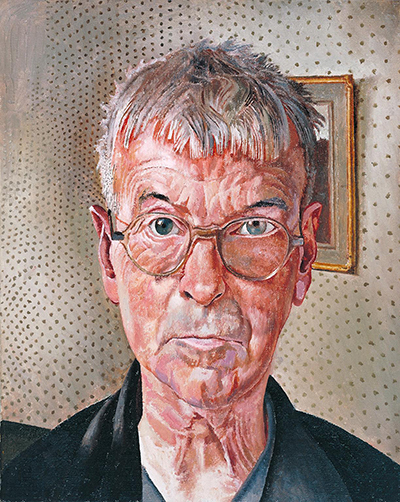His final self-portrait and, indeed, one of his final paintings, shows that Stanley Spencer did not lose his sharply observational eye for his subject, no matter what it was.
Self Portrait 1959, painted mere months before his death from the cancer that was already wreaking havoc in his body, makes a poignant contrast with the handsome youth to be seen in the 1914 equivalent: Spencer's first self-portrait. And yet, this painting does not depict decrepitude or crumbling waste – this is no Ozymandias moment. In contrast to the almost Romantic depiction of his first self-portrait, this one has an almost cartoonish lightness to it, as though it is a caricature, but without the cruel exaggerations so often demanded by that art form. The painter stares fiercely out at the viewer, as though daring them to judge him – or perhaps seeking to put down in brutal oils on canvas exactly what he sees, warts and all with no softening shadows to flatter and no compromises either demanded or given.
The artist has positioned himself against a wall which is papered with a polka dot pattern. On the right-hand side, the dots are evenly and widely spaced, whereas on the left, they seem to indicate that either the wall curves, or that the artist was trying to recreate a shape under the wall-paper. On the right, behind the artist's head, which is centred in the canvas, a picture hanging on the wall can be seen – only the frame edge and the merest hint of a landscape can be seen. The light is falling onto the artist's head from a forward left position, casting much of his left hand side and full face into the light, and allowing shadows to fall on the right. The artist's glasses have slipped a little, and the strong lenses therein cause slight distortions in the artist's eyes – perhaps an ironic comment on aging, sight, and clarity of vision? The eyes in question are opened wide, as though Spencer is intensely trying to see everything – to his own soul, perhaps, and the eyebrows are raised with the effort of his observation.
His hair is greying and slightly tousled, as though he did not prepare himself for this – not even enough preening to grab up a comb – before setting to work with brush and paints, while one lower eyelid droops with age – the other still tight and firm: one of the indignities of aging upon a body that does not care any longer for symmetry. His mouth turns down at the corners, but there is no real sense of sadness or anger. Rather, the emotion seems engendered by effort, as though this work is more than simply another painting. The whole is a portrait of a man concentrating intensely on the task at hand, the job of putting down in oils on canvas the vision that he holds in his head. As with so many of Spencer's paintings, this portrait is in the hands of the Tate Gallery, but is not on display at present.




